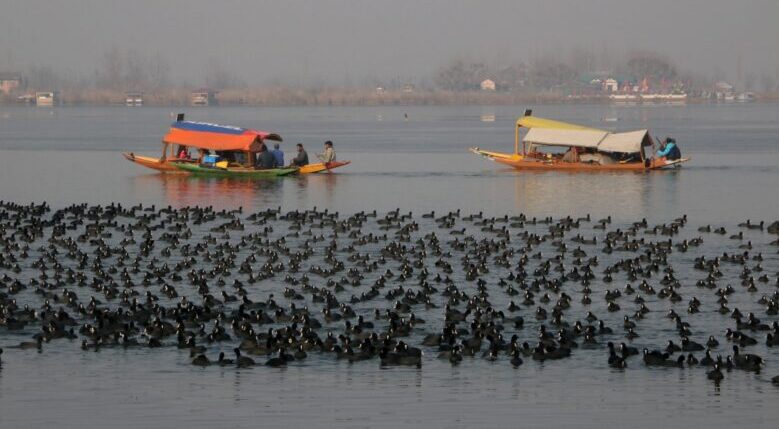Srinagar: Navigating with instinct and skill, hundreds of migratory birds have reached Kashmir from far off lands to ward off the extreme cold of their summer homes.
Migratory birds come to Kashmir every year by the end of October, flying through the central Asian fly zone from Siberia, north China and north Europe to spend the winter months in the less harsh winter here.
The arrival of these avian visitors also heralds the beginning of winter in Kashmir.
Rashid Naqash, Regional Wildlife Warden (Kashmir), told IANS that the bird reserves of Hokersar, Mirgund, Hygam and Shallabugh are the main water bodies where these migratory birds arrive at the beginning of the winter season.
“In addition to these, migratory birds also come to the Wullar Lake and the Dal Lake apart from other water bodies spread all over the Valley.
“The wildlife protection department has staff posted on 24×7 basis to protect the natural habitats of the avian visitors. These birds live here from late October to the end of April. Most of the time, they live inside the water bodies except during their nocturnal visits to the paddy fields to pick fallen grain from there,” Naqash said.
The navigational skills of the migratory birds are a marvel of aviation travel. It is always the eldest bird of the flock, which is well acquainted with the route, who leads the flock in flight.
“If the leader bird dies due to some reason, the next in line takes over the lead. In this manner, the birds cover thousands of miles without losing the track to reach the Valley,” the Warden said.
So far, over 3 lakh migratory birds have reached the Valley and their number is likely to increase manifold during November and December.
Species of migratory birds which come to Kashmir each year include mallard, teal, pochard, wigeon, shoveler, coot, gadwall, pintail, ruffed duck, shelduck and greylag goose.
The bar-headed goose doesn’t come to the Valley, as they go to the Gharana wetland reserve in Jammu division.
In addition to these winter dwellers, some species of birds called the ‘birds of passage’ like the cormorant and sandhill crane also spend some time in the Valley in early winter and late spring while flying to and going back from the Indian plains.
“During extreme winter when the water bodies inside the bird reserves are frozen, the department has to arrange feed by way of rice for the birds inside the reserves.
“To stay alert against poachers, the field staff remain posted inside the designated bird reserves on a regular basis while surprise visits to other places like the Wullar Lake etc. are carried out to keep the poachers at bay.
“The wildlife protection laws are strict in J&K. In addition to seizure of weapon, fine and imprisonment are also part of the punishment for bird shooting in J&K,” said Naqash.
As they descend from the sky into the water bodies, the migratory birds create a spectacle of colour and cackle that is unmatched even by the best ceremonial bands in the world.
For hundreds of years, braving the vagaries of weather and other odds, these avian visitors have never failed to keep their tryst with Kashmir.
(IANS)




















